“I will never forget Shanghai which was my home.” On November 5, Lilli Fliess, a former Shanghai Jewish refugee, accompanied by her three children, returned to Hongkou, Shanghai, to revive her precious memories of her former home. Mrs. Fliess came to Shanghai with her parents in 1939 at the age of 10. She left Shanghai in 1948 and then settled in Israel. In 2001, she came back to Shanghai. This is her second return after 23 years and her first visit to the Shanghai Jewish Refugees Museum.
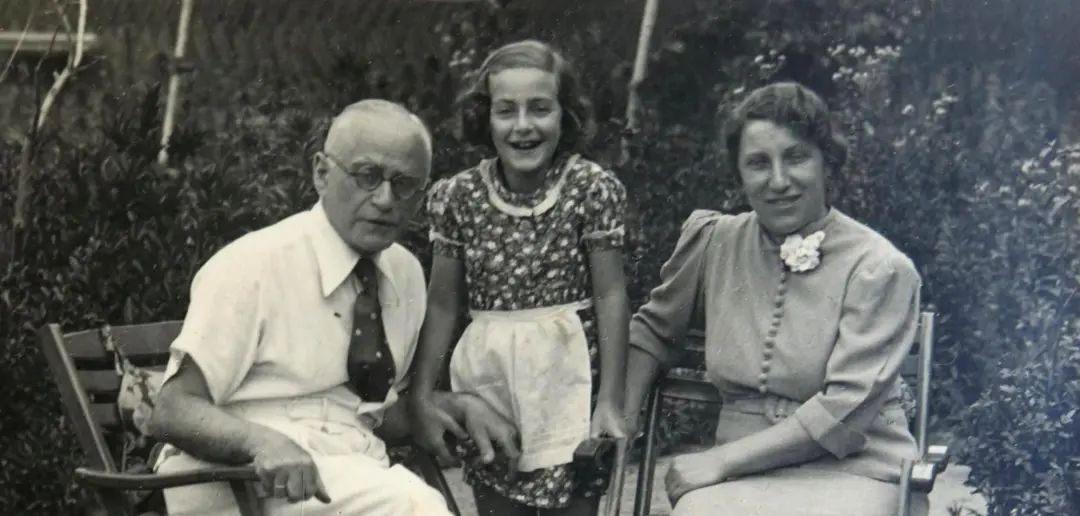
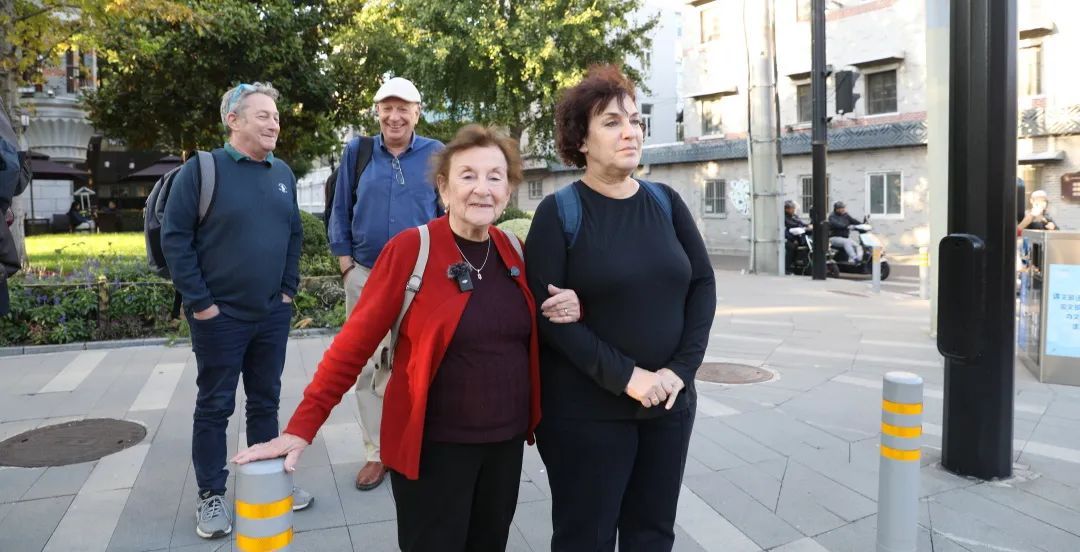
Above: Mrs. Fliess with her parents in Shanghai when she was 10 years old
Below: Mrs. Fliess and her children at the intersection of Zhoushan Road and Changyang Road
At 95 years old, Mrs. Fliess is still in high spirits and good health. She visited her former residence in Hongkou and shared with the Museum staff her experiences of fleeing Germany and living in Shanghai during World War II. She also visited the Museum and searched for the names of her family members and friends on the Wall of Names. The entire visit lasted about five hours, during which she insisted on walking instead of using a wheelchair, to relive the childhood she spent in this land, step by step.
Searching for their former residence in Hongkou
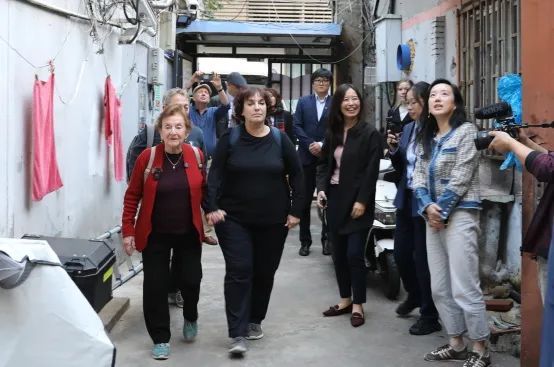
Mrs. Fliess and her children revisiting their home in Shanghai
The former residence for Fliess as a child was at the intersection of Baoding Road and Tangshan Road in Hongkou District. However, due to urban renewal, most of the old houses in this area have been demolished or deserted. Fortunately, the alley where Fliess' former home was located still remains. Although its appearance is quite different from what it used to be, the scenes from over 80 years ago are still vividly clear in Fliess' mind.
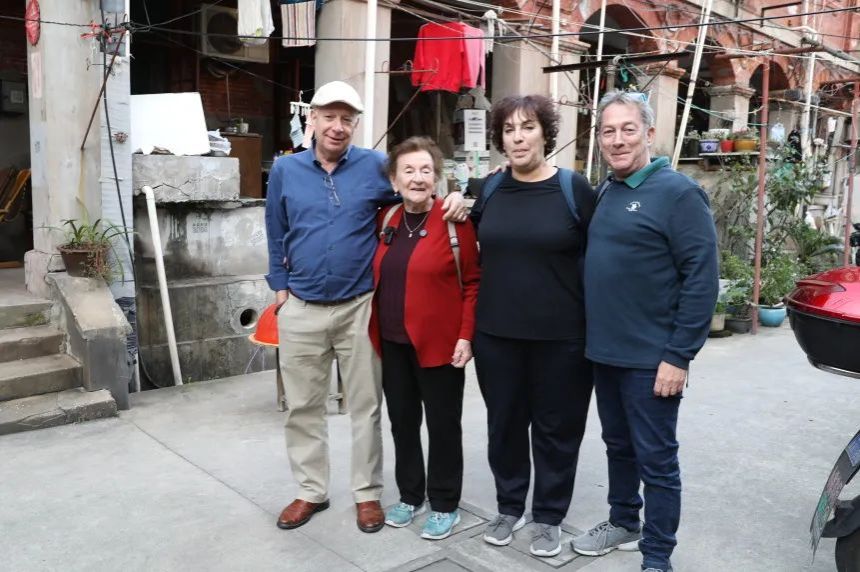
In early November 1939, after many twists and turns, Fliess and her parents finally moved out of the crowded refugee center and found an independent apartment. However, the apartment was shabbier than they had imagined. It was cold in winter and hot in summer, even worse when it was windy or rainy, as the leaking from roof made the whole room damp. Nevertheless, they were grateful to be able to live in a house made of bricks, which was rare and very precious to Jewish refugees at that time. Later, they gradually adapted to life there. Fliess said that she had a happy time singing and dancing with her friends in the alley during her childhood. In the 1940s, the house was confiscated by the Japanese occupation authorities, and Fliess's family had to move out.
Before leaving the alley, Mrs. Fliess waved goodbye to the residents living there today, as if saying goodbye to the past.
Sharing Shanghai Experience
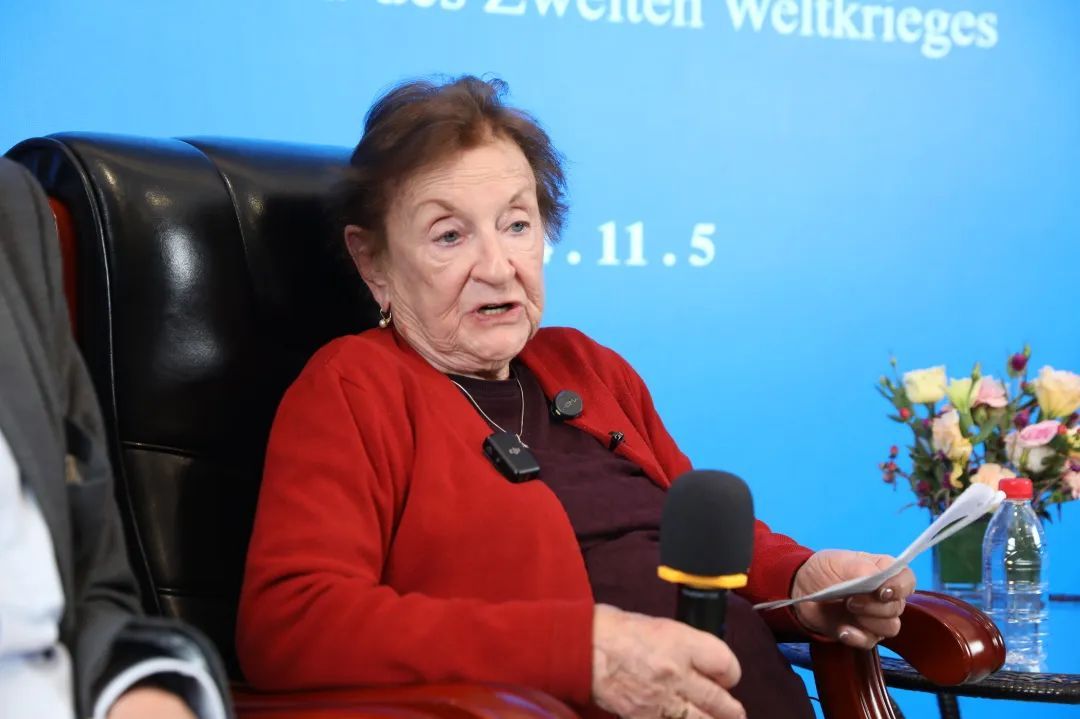
Mrs. Fliess sharing her experience of living in Shanghai
In 2021, a documentary titled “The Last Sanctuary-Erinnerungen an das Exil in Shanghai” was first screened in the Museum. In the documentary, Ms. Fliess and another former Shanghai Jewish refugee Susanne Guttmann recounted the heavy history. This time, the Museum had the honor to have Mrs. Fliess sharing her Shanghai experience in person.
Fliess said that after Kristallnacht, everyone was looking for ways to flee Germany. One day, Fliess’s father rushed to a travel agency. An employee said there were tickets for two adults and one child to Shanghai and asked her father if he had the passports ready and when his family could leave. It was ten o'clock in the morning, her father looked at his watch and said they could leave at two or three o'clock in the afternoon. “That's how we came to Shanghai," she said.
“Life in Shanghai was tough, but compared to Europe at that time, it was like paradise. Shanghai was our shelter, where we found safety and hope”, Fliess said. She said that the war also brought great suffering to the Chinese people and their lives were in difficulties, yet they still lived and worked with great resilience.
Reading her own story in the exhibition
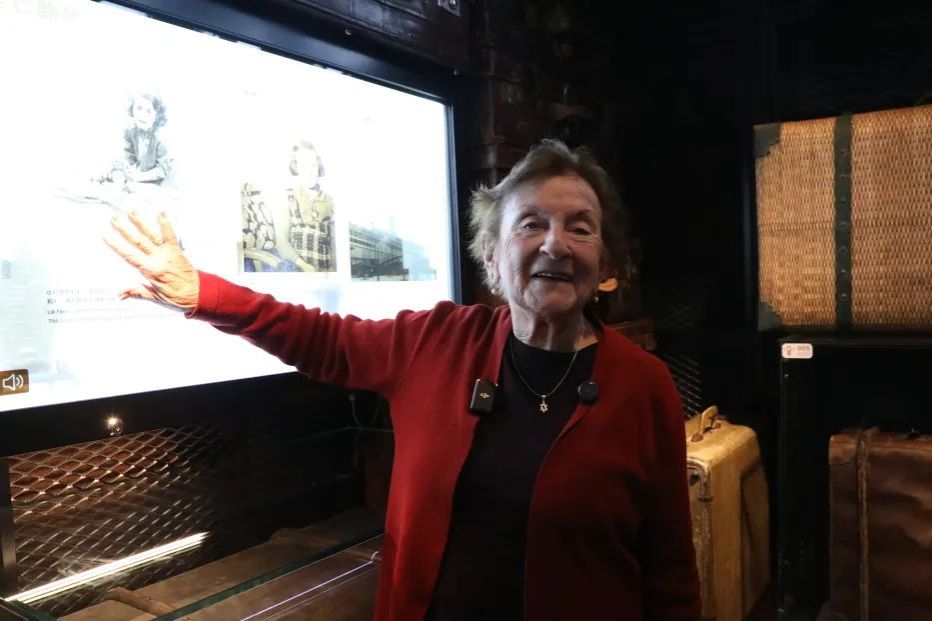
Mrs. Fliess saw her 10-year-old self
In the exhibition hall, Mrs. Fliess saw the passports, tickets, identification cards, suitcases and other exhibits, and her thoughts were immediately pulled back to the 1930s and 1940s, thousands of memories flooding back. “That's the Conte Verde we boarded.” Pointing at the interactive media panel, Mrs. Fliess recalled that her family bought the first-class tickets and enjoyed excellent dining on the ship, where the decor was elegant. With a turn, Mrs. Fliess stopped in surprise, seeing her own story “Lilli Fliess: The Dilemma of Leaving Germany” on one of the media panels.
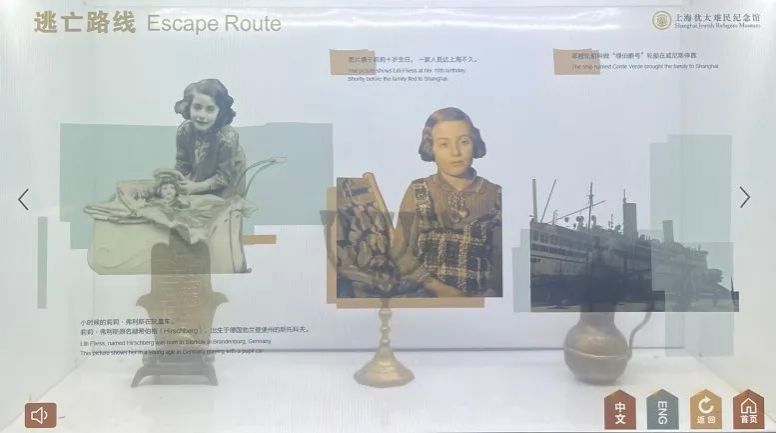
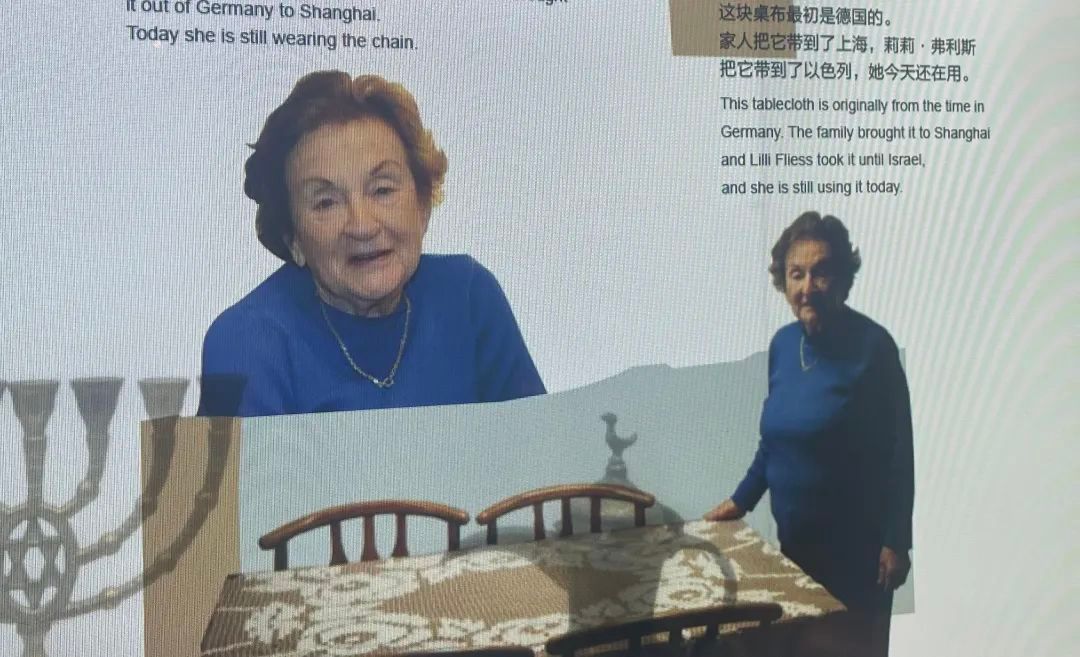
The story of Mrs. Fliess’s family on display in the exhibition
Mrs. Fliess excitedly browsed through the pictures and texts on the screen and introduced to her children and the Museum staff the photos of her parents, the house they used to live in, the bed they once slept in... Finally, she and her three children took a group photo in front of the 10-year-old Fliess, capturing this wonderful moment that transcended time and space.
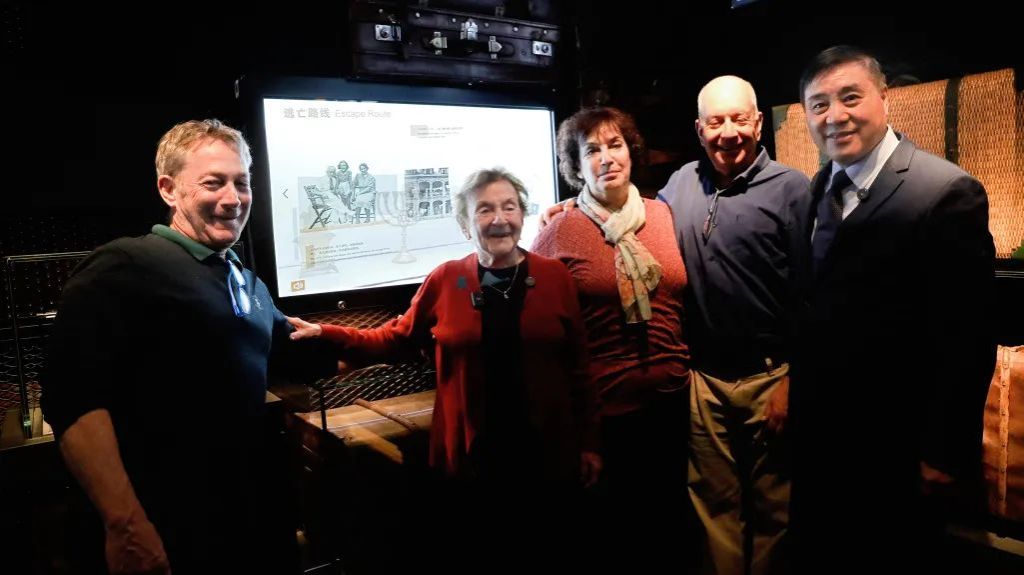
The Fliess family and Director Chen in front of the screen
In front of the Kadoorie School scene, Mrs. Fliess’s eyes were drawn to an old photo, “This is Mr. Leo Meyer, the PE teacher, and this is Lita, my classmate,” said Mrs. Fliess, who attended the Kadoorie School. She still remembered the subjects, including grammar, history, geography, math, as well as interesting singing and dancing classes.
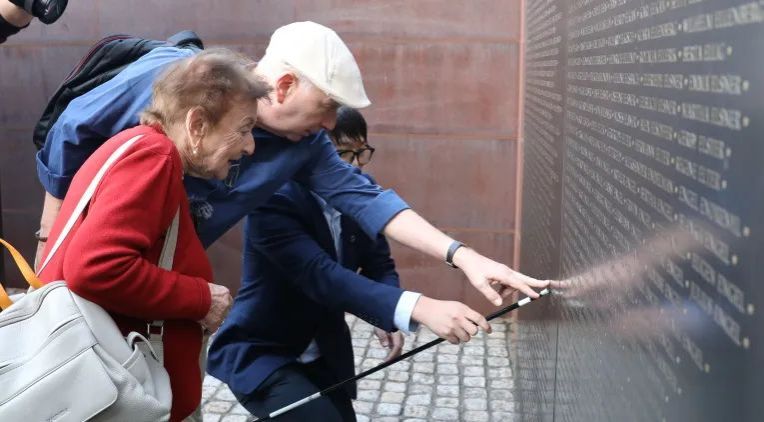
Finding the names of family and friends on the Wall of Names
On the Wall of Names, 18,578 names of former Jewish refugees are engraved. Among the numerous names, Mrs. Fliess first found her former name Lilli Hirschberg. When later she found the names of her family members, teachers, and friends after searching ceaselessly, a smile appeared on the face of the 95-year-old. Though time has passed, the precious memories and experiences are still remembered.
Writing from the heart in three languages
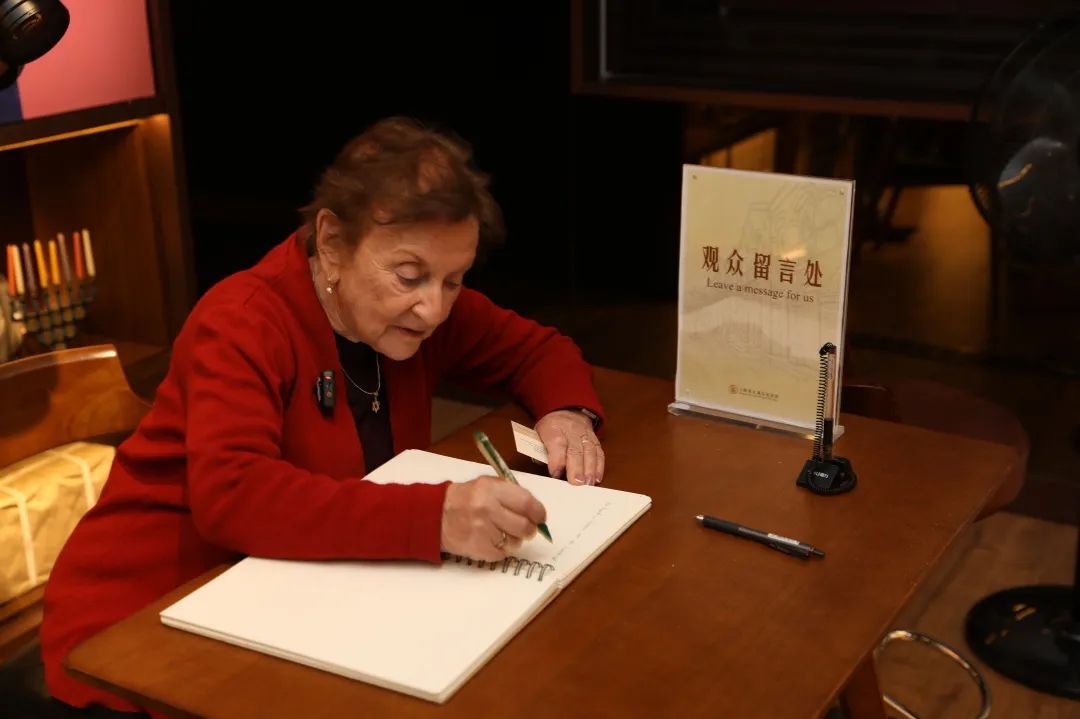
Mrs. Fliess leaving message in the guestbook
At the end of the visit, Mrs. Fliess once again expressed her gratitude to Director Chen Jian, “I was lucky to come to Shanghai and this city saved our lives. I will never forget Shanghai as my home,” Mrs. Fliess said. Her family promised after returning home, they will search for the remaining historical materials and donate them to the Museum, contributing to the preservation of this history.
Finally, Mrs. Fliess left a heartfelt message on the guestbook in Hebrew, German and English respectively.
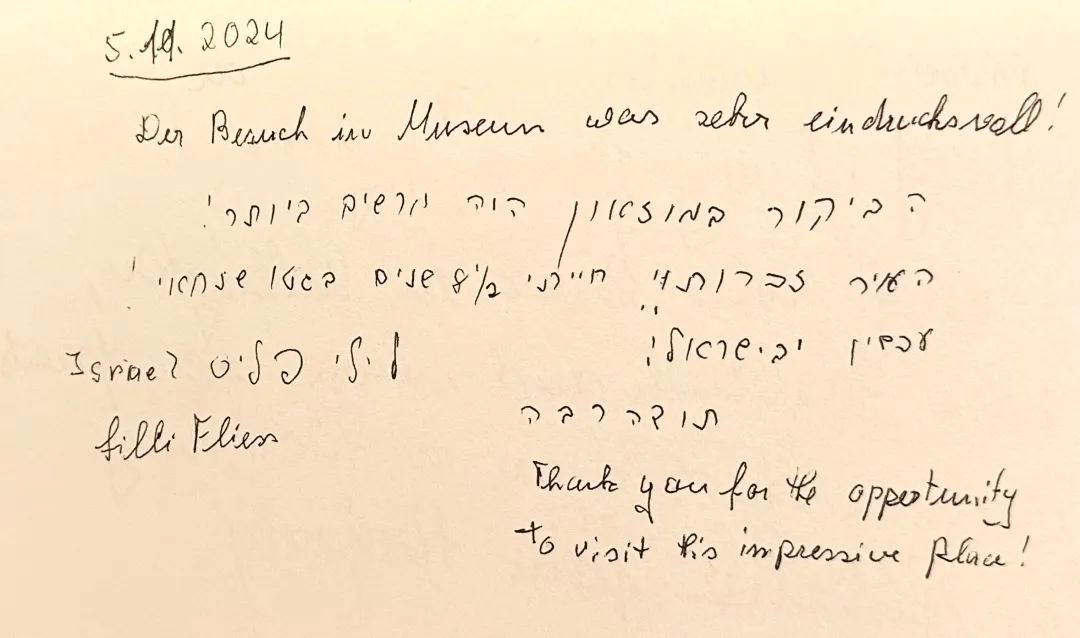
“I had lived in Shanghai for eight and a half years, then moved to Israel. I was deeply touched by today’s visit. I returned to Shanghai today and visited my former home in Hongkou. Thank you for the opportunity to visit this impressive place.”
The story of Mrs. Fliess’s family in Shanghai
Lilli Fliess was born in Germany in 1929. In the summer of 1939, she fled Berlin with her parents and took a ship in Italy to Shanghai. After arrival in Shanghai, the family was first placed in a refugee center in Hongkou. After a month, the family rented a small room on Dalian Road, but the house was confiscated by the Japanese later and they had to move to the intersection of Baoding Road and Tangshan Road.
Although they had temporarily settled down, they still faced the problem of making a living. At first, her father couldn't find a way to earn money, so he had to do housework at home, while her mother worked in a clothing store in the International Settlement. Studying was also essential. At first, Fliess didn't go to school and her parents taught her English and arithmetic at home. In the second year in Shanghai, she started studying at the Kadoorie School. Moreover, her parents had taught sewing skills to Fliess since she was a child, believing that she had a talent for it. Therefore, after graduating from school, she chose to be an apprentice to a tailor.
One day, her mother came home from work with a high fever and was taken to the hospital by ambulance. Fliess remembered that her mother kissed her deeply before leaving. But no one expected that this would be the last time she saw her mother. A week later, her father told her that her mother had died of typhoid fever. This was a huge blow to the family. Her father was devastated and kept cryingwhile she couldn't accept it.
In Shanghai, Mrs. Fliess also found her happiness as she met with her future husband. They returned to Berlin in 1948 with Mrs. Fliess's father and later immigrated to Israel. Mrs. Fliess had three children, and today four generations of the family—her children, grandchildren and great-grandchildren living together in Israel.

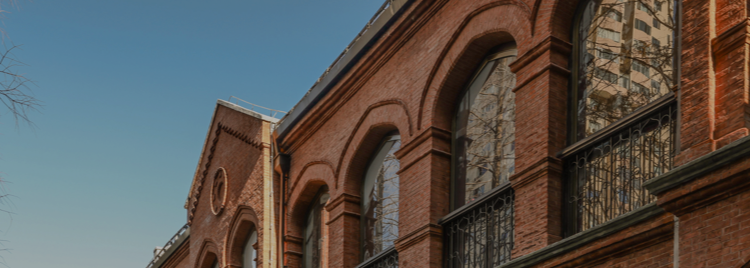
![]() 021-55133186
021-55133186![]() info@shjews.com
info@shjews.com![]() 62 Changyang Road, Hongkou District
62 Changyang Road, Hongkou District

![]() 021-55133186
021-55133186![]() info@shjews.com
info@shjews.com![]() 62 Changyang Road, Hongkou District
62 Changyang Road, Hongkou District